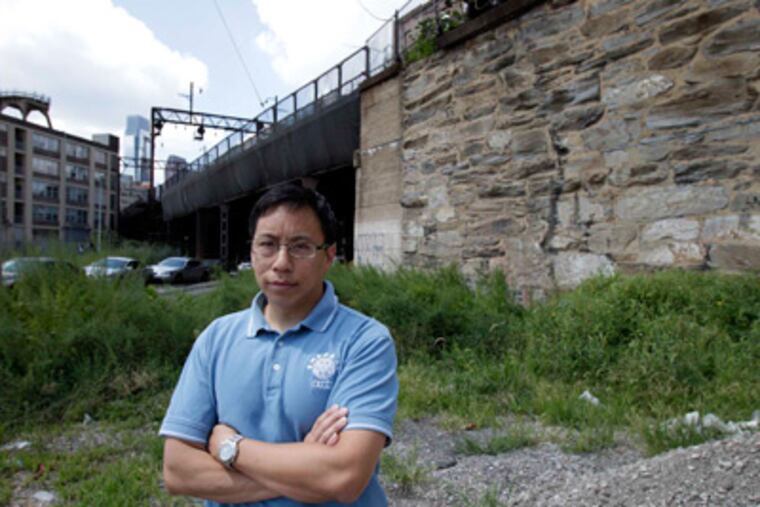Neighbors in evolving Callowhill section debate proposed tax
For years, the neighborhood around Callowhill Street east of Broad Street has been slowly morphing from a wasteland of dead factories and warehouses into an enclave of loft-living artists and young professionals.

For years, the neighborhood around Callowhill Street east of Broad Street has been slowly morphing from a wasteland of dead factories and warehouses into an enclave of loft-living artists and young professionals.
Now, with the city hoping to turn the abandoned Reading Co. railroad viaduct from an aging eyesore into an elevated park to rival New York City's High Line, the neighborhood is poised for an explosive transformation.
But with change comes growing pains, and Callowhill's have been playing out in the fight to create a neighborhood-improvement district similar to the one that for two decades has aided Center City's development.
The Callowhill Reading Viaduct Neighborhood Improvement District would cover an area roughly bound by Vine and Spring Garden Streets, and Eighth Street and Broad.
Properties in that section would be assessed an extra 7 percent tax, raising about $250,000 a year to be used for cleaning streets, planting trees, adding lights, and making other improvements.
Many of the neighborhood's older and lower-income residents, particularly from Chinatown, have objected to creating the improvement district, known as a NID.
They say that they can't afford to pay more taxes and that their communities had been kept in the dark about the planned district, which they see as merely clearing a path for the Reading Viaduct development.
During a City Council Rules Committee hearing on the matter Tuesday, a large contingent from Chinatown filled half the room, holding signs in two languages.
"No to New Taxes" and "Taxation Without Representation," read the signs in English.
"For many people in this community, asking them to pay higher taxes is asking them to make difficult choices," said John Chin, executive director of the Philadelphia Chinatown Development Corp. "Maybe a senior citizen chooses to turn off her heat several hours a day."
Councilman Frank DiCicco, who sponsored the bill to create the Callowhill NID, responded by amending the legislation to carve out a heavily Chinese American area of the neighborhood.
But other members of the Chinatown community still reside in the proposed NID, as do opponents who come from other backgrounds.
"It seems to me," said Philip Browndeis, who lives in the NID's boundaries, "that it is not right for City Council to sanction a tiny group of people with the private power to tax their neighbors."
James Morton, a senior citizen living on a fixed income, also objected to the NID and said the issue had "polarized" a diverse community.
"We've all gotten along," he said. "I've never seen any strife in the neighborhood - until now."
Supporters of the bill filled the other half of Council chambers, holding up pictures of the neighborhood's trash- and weed-choked lots.
Robert Cheetham, who founded the software company Azavea and now employs 32 people in the area, said that on Wednesday, he would be interviewing a prospective employee who lives in New Mexico.
"If he is the right person, I will need to convince him to come live in Philadelphia," Cheetham said. "When you look around this neighborhood, that can be a tough sell."
DiCicco tried to dispel the fear that taxes collected from the NID would be a "direct revenue stream" for the Viaduct project, which would cost an estimated $36 million, according to a recent study commissioned by the Center City District.
The NID's proposed plan and budget would not allow any money to flow to the Viaduct, DiCicco noted.
The Callowhill NID would expire after five years. If the Reading Viaduct has been developed by then, the NID could be renewed, with maintenance of the viaduct included in its plan, said Deputy Mayor Alan Greenberger.
"But that will require a new public-approval process," he said. "Today's proposed NID is about maintaining the sidewalks and public spaces at street level."
Philadelphia has 14 NIDs, the biggest being the Center City District. The money collected is spent only in the districts, which are overseen by management selected by residents.
Two area developers testified Tuesday in favor of the district and said the extra property tax was a negligible amount. One resident said the hike would add about $130 to her current property-tax bill of about $1,845.
"Nobody likes taxes, but this is local taxation at its very best," said John Struble, a neighborhood resident and advocate for the viaduct project.
The bill that would create the Callowhill NID faces another committee hearing before possibly being sent to the entire Council for consideration.
DiCicco described the neighborhood as the "missing link" that would connect the development and growth in Center City to Fairmount and North Broad.
"This is the future of Philadelphia," he said. "This is that hole in the doughnut, if you will, that will really set not only that community but the city of Philadelphia many years ahead."